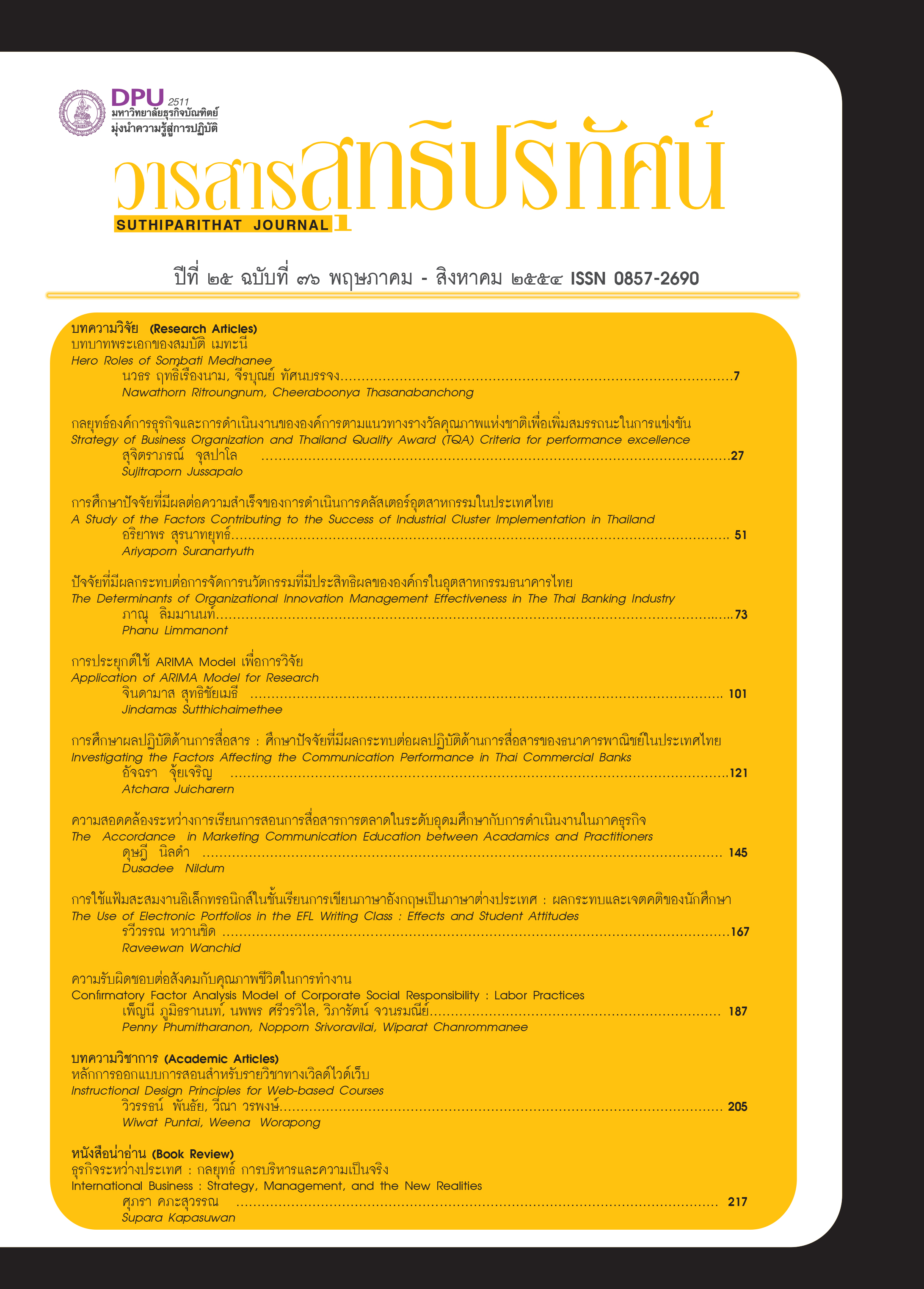การใช้แฟ้มสะสมงานอิเล็กทรอนิกส์ในชั้นเรียนการเขียนภาษาอังกฤษเป็นภาษาต่างประเทศ : ผลกระทบและเจตคติของนักศึกษา
คำสำคัญ:
แฟ้มสะสมงานอิเล็กทรอนิกส์, การสอนการเขียน, ผลสัมฤทธิ์ในการเขียนบทคัดย่อ
การวิจัยครั้งนี้มีวัตถุประสงค์เพื่อ 1) ศึกษาผลกระทบของแฟ้มสะสมงานอิเล็กทรอนิกส์ที่มีต่อผลสัมฤทธิ์ทางการเขียน 2) เปรียบเทียบผลผลสัมฤทธิ์ทางการเขียนภาษาอังกฤษของนักศึกษาที่มีระดับสมิทธิภาพทั่วไปทางภาษาอังกฤษที่แตกต่างกัน (สูง กลาง และต่ำ) และ 3) ศึกษาการเจตคติของนักศึกษาที่มีต่อการใช้แฟ้มสะสมงานอิเล็กทรอนิกส์ในการเรียนวิชาการเขียน รูปแบบการทดลองเป็นงานวิจัยเชิงเดี่ยว ซึ่งมีการเปรียบเทียบคะแนนผลสัมฤทธิ์ทางการเขียนก่อนและหลังการทดลอง โดยการใช้แฟ้มสะสมงานอิเล็กทรอนิกส์และระดับสมิทธิภาพทั่วไปทางภาษาอังกฤษที่แตกต่างกันของนักศึกษาเป็นตัวแปรต้น และผลสัมฤทธิ์ทางการเขียนเป็นตัวแปรตาม กลุ่มตัวอย่าง เป็นนักศึกษาสถาบันเทคโนโลยีพระจอมเกล้าพระนครเหนือคณะวิศวกรรมศาสตร์จำนวน 30 คน โดยการวิจัยครั้งนี้ใช้เว๊บบล็อก (weblog) ที่ให้บริการโดยบริษัท Google เป็นเครื่องมือในการสร้างแฟ้มสะสมงานอิเล็กทรอนิกส์ของนักศึกษา เครื่องมือที่ใช้ในการเก็บข้อมูลเชิงปริมาณได้แก่ แบบทดสอบวัดผลสัมฤทธิ์ทางการเขียนและแบบสอบถามปลายปิด ส่วนการเก็บข้อมูลเชิงคุณภาพใช้แบบสอบถามปลายเปิด และการสัมภาษณ์การวิเคราะห์ข้อมูลใช้สถิติพรรณนา t-test และ One-way ANOVA ผลจากการวิจัย พบว่า 1) โดยเฉลี่ยคะแนนผลสัมฤทธิ์ทางการเขียนภาษาอังกฤษของนักศึกษาภายหลัง การใช้แฟ้มสะสมงานอิเล็กทรอนิกส์เพิ่มขึ้นจากเดิมอย่างมีนัยสำคัญทางสถิติ (p=0.05) 2) โดยเฉลี่ยระดับสมิทธิภาพทั่วไปทางภาษาอังกฤษมีผลอย่างมีนัยสำคัญทางสถิติต่อผลสัมฤทธิ์ทางการเขียนภาษาอังกฤษของนักศึกษา และ 3) นักศึกษาทั้งสามกลุ่มมีเจตคติทีดีต่อการนำแฟ้มสะสมงานอิเล็กทรอนิกส์มาใช้ในการเรียนวิชาการเขียนภาษาอังกฤษ
เอกสารอ้างอิง
Richards, J.C. and Rodgers, T.S. (2001). Approaches and methods in language teaching. Cambridge: Cambridge University Press.
Hedge, T. (2000). Teaching and learning in the language classroom. Oxford: Oxford University Press.
Ekbatani, G. and Pierson, H. (2000). Learner-directed assessment in ESL. Mahwah, NJ: Erlbaum.
Tuksinvarajarn, A. and Watson, Todd, R. (2009). The e-pet: Enhancing motivation in e-portfolios. English Teaching Forum. 1, 22-31.
Love, D., McKean, G. and Gathercoalm, P. (2004). Portfolios to webfolios and beyond: Levels of maturation. Educause Quarterly. 27 (2), 24–37.
Saad, R. and Noor, A. (2007). Malaysian university students’ perceptions on the use of portfolio as an alternative tool in an ESL writing classroom. Masalah Pendidikan. 30(2), 49-64.
Barrett, H. (2006). Using electronic portfolios for classroom assessment. Connected Newsletter. 14(2), 4- 6.
Tillema, H. H. (1998). Design and validity of a portfolio instrument for professional training. Studies in Educational Evaluation. 24(3), 263-278.
Blake, I. I. Bachman, M.K. Frys, P. Holbert, T., Ivan, and P. Sellitto. 1995. A portfolio-based assessment model for teachers: Encouraging professional growth. NASSP Bulletin. 79(573), 37-46.
Paulson, F.L., Paulson, P.R.& Meyer, C.A. (1991) “What Makes a Portfolio a Portfolio?” Educational Leadership. 58(5),60-63.
Valeri-Gold, M., I. R. Olson and M.P. Deming. 1991. Portfolios: Collaborative authentic assessment opportunities for college developmental learners. Journal of Reading. 35(4), 298-305.
Winograd, P. (1995). Putting authentic assessment to work in your classroom. Torrance, CA: The Education Centre.
Wanchid, R. (2009). “How to Implement the E-portfolios in a Writing Class” The Journal of Faculty of Applied Arts, King Mongkut’s University of Technology North Bangkok, 2 (2), 2–13.
Goodson, Todd F. (2007). Electronic portfolio. Journal of Adolescent & Adult Literacy. 50 (6), 432-96.
Liu, J., and Sadler, R.W. (2003). The effect and affect of peer review in electronic versus traditional modes on L2 writing. English for Academic Purposes. 2, 193-227.
Tuzi, F. (2004). The impact of e-feedback on the revisions of L2 writers in an academic writing course. Computer and Composition. 21, 217-235.
Al, Kahtani, S. (1999). Electronic portfolios in ESL writing: An alternative approach. Computer Assisted Language Learning. 12(3), 261-68.
Plough, C.(2008). Web 2.0 Tools Motivate Student Creativity [online]. Retrieved March, 2008. Available at http://www.techlearning.com/showArticle.php?articleID=196605050
Panitchapakdi, S. (1998). "Keynote Speech." The 1998 International Symposium on "The Central Intellectual Property and International Trade Court as a Model for IPRs Enforcement for the 21st Century" in Bangkok on 22 January 1998.
Prapphal, K. (2003). English proficiency of Thai learners and directions of English teaching and learning in Thailand. Journal of English Studies. 1(1), 6-12.
Jerdan, C.C. (1993). Characteristics of low and high achieving students in a selective academic setting. [online]. Abstract from: ProQuest File:Dissertation Abstracts Item : 9327437.
Swatevacharkul, R. (2006). The effects of degrees of learner independence through Web-based instruction and levels of general English proficiency on English reading comprehension ability of second year undergraduate learners. Doctoral Dissertation, English as an International Language, Chulalongkorn University.
Archibald, A. (2004). Writing in a second language [On-line]. Retrieved November, 2006. Available at http://www.llas.ac.uk/resources/goodpractice.aspx?resourceid=2175
Bardovi-Harlig, K. (1995). A narrative perspective on the development of the tense/aspect system in second language acquisition. Studies in Second Language Acquisition. 17( 2), 263-91.
Sasaki, M. and Hirose, K. (1996). Explanatory variables for EFL students’ expository writing. Language Learning. 46, 74-137.
Wongtip, W. (1998). Relationship among English language knowledge, Thai language expository writing knowledge and English language expository writing ability of English major students in higher education institution, Bangkok Metropolis. Unpublished Master’s Thesis. Chulalongkorn University, Bangkok, Thailand.
Pennington, M. C. & So. S.(1993). Comparing writing process and product across two languages: A study of 6 Singaporean university student writers. Journal of Second Language Writing. 2(1), 41-63.
Jansom, S. (2006). The effects of error treatments and students’ language abilities on the usage of English tenses through the use of computer-assisted language learning. Doctoral Dissertation, English as an International Language, Chulalongkorn University.
Thongrin, S. (2002). E-mail peer response in collectivist Thai culture: Task, social and cultural dimensions. Unpublished doctoral dissertation, Indiana University of Pennsylvania.
Wanchid R. (2007). The effects of types of peer feedback ad levels of general English proficiency on writing achievement of KMITNB students. Unpublished doctoral dissertation, Chulalongkorn University, Bangkok, Thailand.
Fraenkel, J.R. and Wallen, E.N. (2000). How to design and evaluate research in education. New York: McGraw Hill.
ดาวน์โหลด
เผยแพร่แล้ว
รูปแบบการอ้างอิง
ฉบับ
ประเภทบทความ
สัญญาอนุญาต
เนื้อหาและข้อมูลในบทความที่ลงตีพิมพ์ในวารสารสุทธิปริทัศน์ ถือเป็นข้อคิดเห็นและความรับผิดชอบของผู้เขียนบทความโดยตรงซึ่งกองบรรณาธิการวารสาร ไม่จำเป็นต้องเห็นด้วย หรือร่วมรับผิดชอบใด ๆ
บทความ ข้อมูล เนื้อหา รูปภาพ ฯลฯ ที่ได้รับการตีพิมพ์ในวารสารสุทธิปริทัศน์ ถือเป็นลิขสิทธิ์ของวารสารสุทธิปริทัศน์หากบุคคลหรือหน่วยงานใดต้องการนำทั้งหมดหรือส่วนหนึ่งส่วนใดไปเผยแพร่ต่อหรือเพื่อกระทำการใด ๆ จะต้องได้รับอนุญาตเป็นลายลักษณ์อักษรจากวารสารสุทธิปริทัศน์ก่อนเท่านั้น







